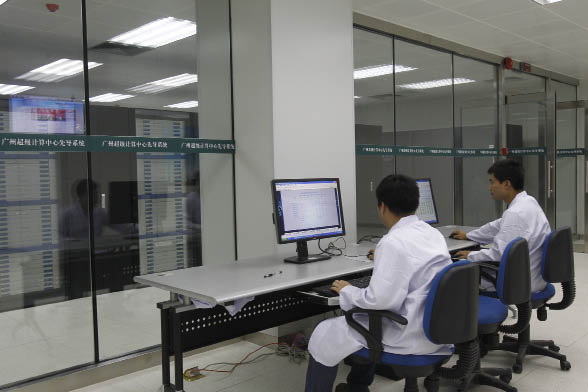Bigger, Faster, More Efficient
By staff reporter ZHOU CHANG
 |
| The supercomputer research center at Sun Yat-sen University in Guangzhou. |
SUPERCOMPUTERS operate at levels far beyond the ordinary PCs that sit on so many modern desktops. But rather than being the computer world’s equivalent to ripped superheroes like Superman and Spiderman in their colorful, all-revealing spandex costumes as their name suggests, supercomputers’appearances more resmble these icons’ awkward, unassuming alter egos.
This is no less true of Tianhe-1. A first glance at China’s fastest supercomputer might make you think you had accidentally stumbled upon the building’s archaic filing system, with row upon row of identical cabinets filling the brightly lit room. Yet this clumsy-looking machine has a peak computing rate of 2.566 petaflops.
Since Tianhe-1’s accession to the top of the Top 500 list less than three years ago, this spot has been filled by a succession of ever-faster newcomers. On November 12 last year the U.S.-made Titan snatched the No. 1 place, and though the U.S. and Japan are still at the top of this technology, there can be no doubt that, thanks to decades of unrelenting efforts, China’s research and development in supercomputers has made it a worthy competitor.
From Mega to Peta
China’s independent supercomputer R&D capacity has improved by leaps and bounds over the past few decades. In 1983, with the debut of Yinhe-1, China became the third country in the world to produce a supercomputer that could perform at a speed of 100 megaflops.
Though impressive at that time, it would take well over 15 million Yinhe-1s to crack even the top 10 list today. The thickly distributed welding spots at the back of each circuit had to be welded manually, and the thousands of cables filling the computer cabinets had also been connected by hand.
It was another two decades before China produced Yinhe-1’s successor, Dawning 4000A, in 2004. It entered the world’s top 10 list in June that year, a position that made it a historic machine for China. Four years later, Dawning 5000A, capable of 180 teraflops, also stole the world’s No. 10 position. The New York Times commented that the birth of Dawning 5000A signified that China had joined the world’s leaders in the high performance computer field.
At this time the holy grail of supercomputers was the speed of one petaflop, which the U.S. had been planning on breaking since the 1990s. However, it was not until June, 2008 that IBM ushered in the era of the petaflops supercomputer when its creation Roadrunner hit a speed of 1.026 petaflops.
With China’s top supercomputer having just broken the 10 teraflops barrier, it looked like the country’s efforts were flagging, but another historic moment for China came the very next year. In October 2009 China impressed the world with the entrance of Tianhe-1, becoming the second country in the world after the U.S. to manufacture a supercomputer with an operation rate beyond one petaflop.

